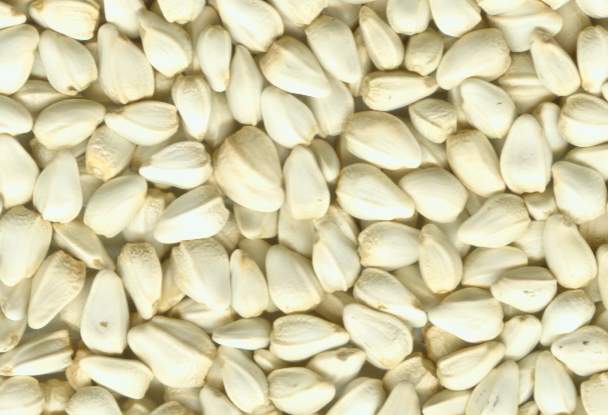
Safflower seed oil
Safflower oil is derived from the seeds of safflower. Although safflower was known in ancient times, safflower oil has not been used as an important commercial vegetable oil for a long time. Safflower is an annual herbaceous plant of the Asteraceae family, distributed in the temperate zone. China is prolific in the northwest, especially in Xinjiang and Tibet, followed by North and Northeast China.
Safflower seeds contain 29%-45% oil and look like sunflower seeds. The shell content is 30%-55%. Safflower oil grass yellow to golden yellow, clear and transparent.
Safflower oil physicochemical constants:
Relative density (d20°C4°C) 0.9190-0.9240
Refractive index (n20°CD) 1.4750-1.4769
Freezing Point (°C) -20~-13
Viscosity (E020°C) 9.6-10.8
Fatty Acid Freezing Point (°C) 14.0
Iodine value (g iodine/100g oil) 138-150
Saponification value (mgKOH/g oil) 187-194
Unsaponifiable (%) 0.6-1.5
Fatty Acid Composition of Safflower Oil (%):
Palmitic acid 5.5-6.4
Stearic acid 1.2-3.1
Oleic acid about 21
Linoleic Acid 73
Safflower oil is known to contain the highest linoleic acid in vegetable oils and is a good source of linoleic acid, so its semi-dry oil has the highest iodine value and its nutritional value is also high. Mixing 30% safflower oil with 70% rice bran oil has a significant effect on lowering cholesterol in human serum, so this oil is called "healthy nutrient oil." Experiments have shown that safflower oil can not only make serum cholesterol and triglyceride significantly lower in some animals, but also cause a significant regression of atherosclerosis. The saffron produced in Xinjiang in China and the saffron produced in Tibet enjoy a high reputation both at home and abroad.
The preparation of safflower oil is machine-pressing or leaching, and the oil is edible. In foreign countries, safflower oil is generally made into artificial butter, mayonnaise and salad oil for human consumption. The color of safflower oil is very light, and it can be bleached after heating. It is a good raw material for making advanced white paint. Paints and non-yellowing alkyd resins can also be made.
Safflower seeds
First, the product description:
Safflower seeds, also known as grass safflower, chrysanthemum safflower, red orchid, safflower, etc., are annual dicotyledonous herbaceous plants. The prickly nature of safflower and its stringent requirements on environmental conditions have limited its worldwide distribution and is therefore a typical small oil crop. The history of the introduction of safflower in China has been more than a decade. Nowadays, Heilongting, Liaoning, Xinjiang, Gansu, Inner Mongolia, Shaanxi, Henan, Hebei, Jiangsu and Zhejiang have certain cultivation areas.
The safflower seeds are achene, smaller than sunflower seeds, oval or obovate, about 5 mm long, slightly skewed at base, white, without crested, with quadrangular. The Chinese medicine is called "blood". Thousand grain weight 33.6-49.8 grams. The outer layer is a relatively thick white protective shell, which is smooth and ridged. A thin seed coat is attached to the shell, the embryo is encased in the seed coat, and the oil and protein are contained in the embryo. The safflower corolla has white, yellow, orange, pink, scarlet, and dark red.
Safflower seeds contain 25% to 37% oil, 15% to 19% crude protein, and seed oils up to 55%.
The process of safflower seed oil making is mainly based on peeling and pre-extraction. Safflower oil is bright orange, delicious and delicious, and the amount of linoleic acid in oil is higher than other oils (up to 56%-80%). Consumption of safflower oil can lower cholesterol, and can be processed into margarine, mayonnaise and salad oil, etc. It is a very good edible oil. In addition to the Chinese safflower corolla can be produced, but also from the colored corolla red, yellow, orange and other natural dyes and food coloring, safflower orange rod and cake after oil extraction, is a livestock high-quality feed.
Second, the custody method:
Safflower seeds are solid, shelled oils, and their skin is thick and hard. The harvesting season is conducive to storage and storage in the autumn. Even if it is processed for a long time, it is not easy to degenerate. However, during storage, we must pay attention to moisture: in the long-term preservation of the air, the water-containing safflower seeds are prone to mildew and deterioration.
Safflower seed oil is easily oxidized and rancid because of its high content of unsaturated acids. According to Japanese studies, the relationship between oxidation rate and temperature is small, and it is proportional to residual water and oxidation rate. Therefore, when long-term storage is performed, due to the effect of residual water, hydrogen bonds between hydrogen peroxide and peroxygen are generated. 14ppm water oil is also oxidized. If the water contains more than 220pm, the oil will accelerate oxidation due to free water. The obvious is that the peroxide value increases, the acid value increases, and the safflower oil to be preserved for a long time must be dehydrated. . In addition, the oil should be stored in a cool and ventilated place, and it must not be exposed to the sun to prevent the entry of heavy metal ions.